Brand websites are an invaluable channel in a consumer’s buying journey and brands should adopt a robust direct-to-consumer strategy to establish a holistic online retail presence. Google research shows that a brand website is critical to a brand’s online success and reveals insights for building a robust brand website strategy.
For retailers, 2020 was a year of accelerated digital adoption. With restricted movement and people spending more time at home, consumers turned to digital to meet more of their everyday needs. Now with many people using digital services for the first time – and more than 90% of users saying they will continue to use these services in the future – it’s more important than ever for brands to invest in a digital presence.
In our research with Ipsos and Sixth Factor of both brand websites (Brand.com) and marketplaces in Singapore, Indonesia and Thailand, we discovered the significance of the roles of each platform in consumers’ paths to purchase across verticals such as consumer electronics, home appliances, apparel, sportswear and beauty products.
We learned that 55% of shoppers used a brand’s website at some stage during their path to purchase, indicating that Brand.com is an invaluable channel in consumers’ buying journey, alongside marketplaces.

Our study found that people expressed strong intent to continue using Brand.com in the future. So now is the time for brands to focus on adopting a robust direct-to-consumer strategy to establish a holistic online retail presence.
Here, we unpack three key insights from our research that show why Brand.com is critical to a brand’s online success and how marketers can build a robust Brand.com strategy.
- Shoppers want an immersive experience that helps them explore products in detail
As many people have not been able to visit retail stores in the past year due to pandemic restrictions, more and more consumers have turned to brand websites to explore products and services. This is an opportunity for brands to create a unique, personalised brand experience on their website. This gives them an edge in offering experiential shopping because they can create a frictionless experience for customers, with everything from interactive ways to explore their products, to videos and images that clearly outline product details and pricing.
Around 41% of Brand.com shoppers indicated that brand websites give them an immersive experience and these shoppers are motivated to use these websites because:
- They offer clear product specs;
- They show product specs using photo or video assets; and
- They are easy to navigate.
Buyers also indicated that they are motivated to use Brand.com because it offers a way to compare products from the brand.

— Singaporean Brand.com shopper
As brands think about their Brand.com, it pays to look at the customer experience from different angles. Inconsistent experiences across platforms or changes between desktop and mobile views can result in a sub-par customer experience.
- Shoppers turn to Brand.com for a sense of assurance on their purchase decisions
When shopping on a brand website, 42% of shoppers said they felt the product they were purchasing was trustworthy or authentic, while 41% said they were assured that the information on the website was correct.
Brand.com also allows customers to directly communicate with the brand for after-sales customer care and service.

Consumers are also using brand websites to make more informed purchase decisions, with 69% of shoppers using Brand.com to look for better pricing or promotions.
Price-sensitive shoppers then prefer to make their purchases on marketplaces because of special deals or discounts. These promotions are often rated as the top reason why consumers choose to shop on marketplaces over a brand website.
With the right strategy, brands have the opportunity to offer more value-added services to build better, long-term relationships with their customers, such as extended warranties, flexible return policies, shipping deals or ‘refer a friend’ promotional codes.
— Singaporean Brand.com shopper
Driven predominantly by these additional brand services and add-ons, consumers say they are willing to spend 20% more on an average order when making purchases on Brand.com.
Average spend across categories

Source: Google, Ipsos and Sixth Factor, Brand.com and Marketplace in the evolving online path to purchase, January 2021
- Shoppers want to connect with brands on their terms
When it comes to Brand.com, consumers want localised content, from ensuring content is in a language they are familiar with to being able to find and buy products they have viewed online via local brand websites.
For non-English speaking markets, local-language options can contribute to a greater sense of trust and reliability. A key barrier for non-buyers to discover more about products was that a brand website was in a foreign language, making it difficult for shoppers to learn more about a product or delivery options.
At the same time, localisation also ensures products available in-market are listed online (not just found in-store), while providing local warranties for people purchasing from overseas retailers can also help instil confidence in a brand.
— Thailand Brand.com shopper for consumer electronics
With this in mind, a localised strategy is essential to stay relevant with shoppers but brands should make sure it is curated for each market.
The roles and opportunities of Brand.com vary across SEA markets

With Brand.com, brands are building a first-party data ecosystem, which can help personalise and localise the experience that shoppers crave. By engaging the right customers and finding ways to continually connect with them, brands are future-proofing their brand and ensuring long-term value.
It is critical for brands to fully invest in a balanced digital presence that includes Brand.com. Shoppers want to be able to discover, research and evaluate their options and make their purchase seamlessly.
As our research reinforces, Brand.com plays a crucial role throughout these consumer journeys. For online retail success, owning and building customer relationships through Brand.com will be key to the future growth of business.
This article was originally published on Think with Google.

